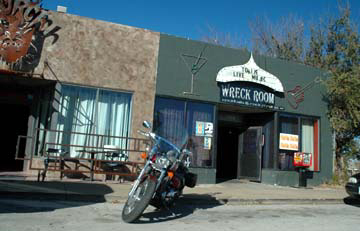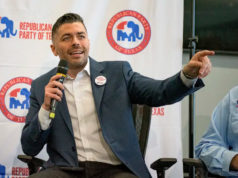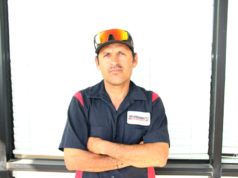 Even when Fort Worth Weekly first detailed the specific plans of the Museum Place development last February, many locals took an “I’ll believe it when I see it” attitude. After so many years of hearing about new housing and retail and hotels and office buildings being touted for their area, talk was cheap.
Even when Fort Worth Weekly first detailed the specific plans of the Museum Place development last February, many locals took an “I’ll believe it when I see it” attitude. After so many years of hearing about new housing and retail and hotels and office buildings being touted for their area, talk was cheap.
This time, however, developers have put their money where their mouths are: Workers are already turning dirt on the 11-acre, $150 million Museum Place. Within a year, unless some major roadblock develops, the land bounded by Camp Bowie Boulevard, West Seventh Street, and Bailey Avenue will no longer resemble anything that is currently standing. The dominoes are starting to fall, and the old neighborhood where young rockers have made noise for over a decade is almost history. New electric lines and underground utilities are being laid behind the Wreck Room in its neighbor’s parking lot, Chase Bank. Soon, some familiar buildings will fall to the wrecking ball, and a flock of construction cranes will arrive, to nest on the near West Side for the next two years.
The first to fall will be The Torch nightclub, which is closing on Nov. 25. It will be replaced by an eight-story mixed-use building: retail and restaurants on the first floor, four floors of office space, and about 35 condominiums on the top three floors. Construction, as well as on the new Arlington Heights post office branch on the pie-shaped piece of land (currently a car wash) between Bailey and University at the big six-way intersection, is scheduled to begin on Jan. 1.
After that, the pace of the project will pick up even more. The property currently occupied by the Wreck Room and West Seventh Street Barbershop will be razed in six to eight months, according to Richard Garvey, president of Jagee Properties, the principal developer of Museum Place. Another six months later, the property where the current post office and J&J’s Hideaway bar now sit will be torn down as well. On both the Wreck Room and J&J sites, new four- or five-story buildings will go up that will include about 240 rental units each, plus first-floor retail, restaurants, and high-end nightclubs.
For people who think in terms of how their bar-hopping life will change, this is the scorecard: About two more weeks to get drinks at the Torch, the last music will play at the Wreck Room next spring, and no more drinking by the J&J fireplace after next fall.
Brian Forella, who owns both The Torch and the Wreck Room businesses, is not necessarily pleased with the fairly quick exit of both of his clubs, but also knows change is inevitable. “They gave us 60 days notice on the Torch, and that was part of the lease we had,” Forella said. “We haven’t heard anything about the Wreck Room from [Jagee], but we figure we’ll be gone by summer. I just hope we make it through our 10th anniversary in April.”
Forella says he has had numerous offers of new locations for the Wreck Room and is keeping his options open. But leasing space in the new development is out of the question. “No, this just isn’t my kind of deal,” Forella said. “I get the feeling that most of this development will be more mainstream than what we do. I think what we have done in the Wreck Room for the past decade has been significant for Fort Worth’s music and cultural scene. But that isn’t what [Jagee Properties] is going after, so it’s time to move on. But I do hope they realize this is a cultural district they are re-doing, and a cultural district includes a whole lot of different arts venues, not just Starbucks and other national chains.”
Garvey says that he hopes for a mix of national chains and local businesses. For example, the barbershop will be offered the chance to stay open in a portable building during construction and then a permanent lease option when the development gets built out.
But national chains will be part of the equation. “For this development being the type that it is, it begs to have some tenants like that,” Garvey said. “I appreciate what people have to say. … But we will have visitors who will be coming to this project besides those who live in the neighborhood. We hope they will shop here and eat here and stay here. And so we are looking at a universal demand, not just what somebody up the street wants to have. If [the neighbors] want to have a say in it, they can buy it.
“If a company like Crate and Barrel, one of the highest end retailers in the country, said they want to be here, you’d have a hard time saying no,” Garvey continued. “We are trying to have quality development, and we will have a mix of different uses.”
Monticello Neighborhood Association president Gloria Bradfield has heard that both national and local chains will be moving into her neighborhood. “As to whether we need one versus the other, I am not qualified to answer,” she wrote in an e-mail. “I will say that after living here as long as I have, it will be nice to have more options.
“Jagee and Mr. Garvey, along with the architect, have been upfront with their plans with us,” she continued. “We contacted them and asked to come … meet us, show a presentation, and field questions and concerns from our membership, which they did. I personally think that any time there is change, especially on this level, people at first get anxious and nervous.”
Several aspects of the plans still need to be worked out. Jagee is still negotiating with the 7-Eleven store at West Seventh Street and Arch Adams to move them to a first-floor retail slot just west of the current location (but without gas pumps). Local oilman Barney Holland, who owns the Texaco gas station at the corner of the major intersection, had originally wanted to do his own triangular flatiron type building on the property. But negotiations are going on to buy the gas station property and build a three- or four-story building there. “Barney [Holland] has always been cooperative with us, and we’re working on putting the final touches on the agreement there,” Garvey said.
The new post office plans will be presented to Fort Worth City Council on Nov. 14. They include a Texas mural highlighting weather changes and an outdoor sculpture using the bent metal billboard supports that were damaged in the 2000 tornado. Garvey also wants to extend West Sixth Street (currently part of the Chase Bank parking lot) from Arch Adams to Bailey to allow better access to the new post office, though that hasn’t been approved by the city yet, or even officially proposed.
Jagee will ask the city for public funding for the development, possibly via tax abatements or something called a “380 grant,” a funding vehicle created by state law that allows cities to invest public money in private developments to “close the gap” between the investment and profitability. The Trinity Bluff housing and retail project just east of downtown received a $4.7 million 380 grant this past summer, to make it possible for some of the apartments to be offered at “affordable housing” rates. “We are working on an incentive package with the city, and we have just begun that process,” Garvey said.
There are many issues still at play — how to handle increased traffic congestion at an already-crowded intersection, negotiations with hotel companies to operate the 180-room planned hotel, and which current businesses stay and which ones go.
Garvey said that all the buildings will be completed by the end of 2008, though interiors may have be left undone depending on the retail tenants or condominium buyers. The development will include parking garages located in the center of structures, away from the street. Infrastructure for light rail will be built into the streets, should that kind of mass transit ever make its appearance in Fort Worth.
The change to the neighborhood will be significant. The new buildings will have very little setback. While most local developments provide surface parking lots, Museum Place will have plazas and a more pedestrian-oriented layout than Fort Worth is used to.
But the biggest changes will be more philosophical and neighborhood-oriented. The pie-shaped pieces of land near the museums have always served the neighborhoods just to the west, with a barbershop and dry cleaners and little bars that many locals could walk to. The new development will have a different-feeling set of retail businesses and nightclubs.
“Some of the Wreck Room customers think we should protest and all that,” Forella said. “But I think that will just be a waste of time. We came down here and invested in an area that didn’t have a live music club like the Wreck Room, and we added to the neighborhood. It was like our little playground. But the playground is being taken away, so we’ll just move the playground somewhere else. That’s all we can do.”











